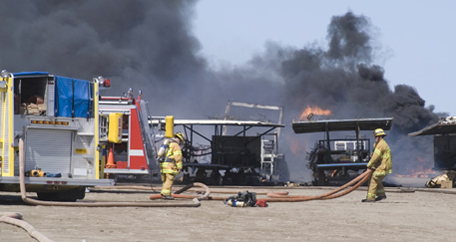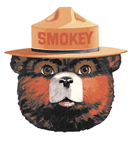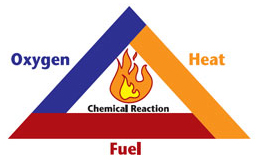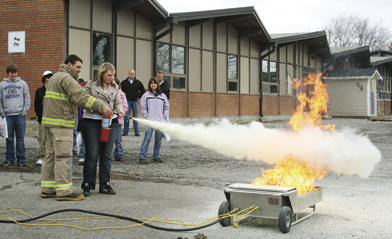Training Room 2: Keeping Safe and Healthy—Standards and Practices in an Agricultural Environment
Session 1: Fire Safety—Standards and Practices
Fires on farms cost money and lives. According to the National Agricultural Safety Database, the leading cause of agriculture fires is open flame caused by candles, matches, bonfires, sparks, static electricity, friction, welding, and equipment. Other causes of fires may include natural sources such as spontaneous combustion and lightning. Farms are at higher risk of economic losses because of decreased access to fire-fighting equipment and perhaps inadequate water supply for fighting a fire.

iStockphoto/Thinkstock
Learning Target
In this session you will examine standards and practices associated with fire safety and demonstrate your understanding by answering the following questions:
- What is a potential scenario for a fire hazard on your agricultural worksite?
- How would you plan to address fire safety on your worksite?
Use the following resources to support your learning. Click on each horizontal tab to find out information about each topic.
Elements of Fire
Understanding Fire

Courtesy of the Forest Service, USDA

Visit Smokey Bear's website to learn about the basic elements of a fire in a fire triangle/tetrahedron. The elements of a fire are the three conditions that must be present to create fire. The fire triangle you see on the right is a model used to show these required fire elements.

Photos.com/Jupiterimages
/Thinkstock
Go to On Fire, an interactive website by Nova Online (PBS), to learn more about the basics of combustion.
Fire Classifications and Appropriate Extinguishers
Fire Classifications
The combustible fuel of fires and the substance that is needed to put out the flames both determine the classification of the fire. This classification is also used to categorize the fire extinguishers that are used to effectively and safely put out the flames.
| Class A – combustibles such as wood, paper textiles, where a quenching, cooling effect is required | |
| Class B – flammable liquids, gasoline, oils, fats, paint, where oxygen exclusion or flame interruption is essential. | |
| Class C – live electrical wiring, motors, appliances, where non-conductivity of the extinguishing agent is crucial. | |
| Class D – combustible materials, magnesium, sodium, and potassium. |
Classification of Fire Extinguishers
Fire Extinguishers
Specific fire extinguishers should be available for specific locations. Using the wrong kind of extinguisher dangerous. For example, using a water-based extinguisher on an grease or electrical fire can cause the fire to spread or lead to electrocution of the user!
An ABC type extinguisher can be used safely on A, B, or C fires.
-
Read more about about the different kinds of fire extinguishers on the document FIRE FACTS: Fire Extinguishers from Alberta Municipal Affairs.
-
Look at a chart that describes the different fire extinguishers and their uses on the KNOW YOUR FIRE EXTINGUISHERS: Safety Information Site from the University of Alberta.
- Watch to help you recognize the different classifications of fire extinguishers.
Be sure to find out the location of fire extinguishers on your agricultural worksite and learn how to use them safely.
Awareness and Control of Fire Hazards on the Farm
Common Fire Hazards on a Farm
The following are some fire safety hazards on a farm:
- flammable/combustable materials
- machinery/fuel
- ignition sources
- electrical systems and devices
- hot work (welding etc.)
- construction of buildings
In Agricultural Fire Safety you can read about the details of how to control some specific agricultural hazards.
Recommended Extinguishers for Specific Places/Hazards on the Farm
Extinguishers for Specific Places
Specific kinds of fire extinguishers are needed in specific locations on your farm. This is determined by possible combustible materials in the area and what class of fire that the location is at risk to have.
Each area of the farm could have unique fire hazards depending on the materials and equipment present.
| Workshop | 10 pound dry chemical, multi-purpose ABC extinguisher 5 pound dry chemical ABC extinguisher |
| Barns | 10 pound dry chemical, multi-purpose ABC extinguisher 2.5 gallon pressurized water extinguisher |
| Farm Vehicles | 5 pound dry chemical, multi-purpose ABC extinguisher |
| Combines | 10 pound dry chemical, multi-purpose ABC extinguisher 2.5 gallon pressurized water extinguisher |
| Balers | 2.5 gallon pressurized water extinguisher |
| Tractors | 10 pound dry chemical, multi-purpose ABC extinguisher |
| Silos | 20 pound dry chemical, multi-purpose ABC extinguisher 2.5 gallon pressurized water extinguisher |
Alberta Farm Safety. Used with permission.
Use of a Fire Extinguisher

Courtesy of Wendy Molenaar, WMM Photography and The Canadian Agricultural Safety Association
Using a Fire Extinguisher is a brief video outlining how to use a portable fire extinguisher. You might also want to enter the search term "How to Use a Fire Extinguisher" in your internet search engine.
How to Use a Portable Fire Extinguisher Training Video is an animation that teaches you about P.A.S.S.
Checking In
Your Tasks: Planning to Prevent Fires on Your Agricultural Worksite
Your Tasks
- Think about your farm worksite. Develop a possible scenario in which a fire breaks out in a specific area of your farm. The scenario should answer these questions:
- Where do you see the greatest risk of a fire breakout? Why?
- What are the particular fire hazards in that area?
- What are the most important fire prevention resources and procedures that are in place or should be in place?
- How would you respond if a fire broke out in that area of your worksite?
- Where do you see the greatest risk of a fire breakout? Why?
- Learn to use a fire extinguisher that is in place on your worksite.
 Demonstration Assignment: Portable Fire Extinguisher Use
Demonstration Assignment: Portable Fire Extinguisher Use
In addition to your fire scenario, you will be required to demonstrate your understanding of how to use a portable fire extinguisher to your instructor.
Depending on individual circumstances and the wishes of your teacher, this skill may be demonstrated in a lab or in the field under the supervision of an individual with training in worksite/workstation safety, or in a virtual situation such as a video or video conference.
If your demonstration is done on your worksite:
- Ask the adult to complete this Acknowledgement of Fire Extinguisher Training form.
- Submit it to your teacher.
- Discuss your scenario.
Share your scenario with your classmates or with a learning partner. Comment on one other student's scenario, indicating if you agree or disagree with the prevention strategies chosen and explaining why.
If you want to demonstrate your understanding of fire safety in your Risk Management Tutorial Project, you can use the scenario you created to help describe the standards and practices for fire safety in your workplace.